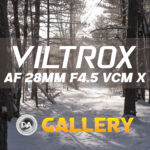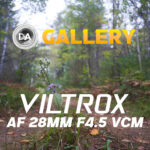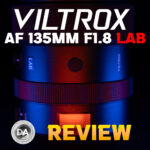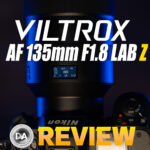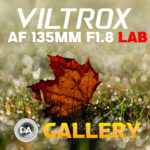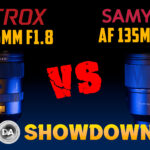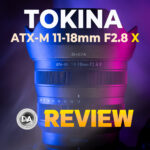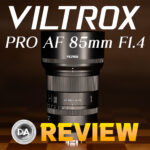
In September of 2024 I released a review of the Viltrox AF 28mm F4.5 “Chip” lens for Sony E-mount. One of the most common requests I got in the responses to my review was for a Fuji X-mount version. I found that interesting, as the “Chip” (Viltrox’s name for the lens) is a full frame lens. But I found that when I was recently reviewing the new Fujifilm X-M5 I actually wished for a lens like this one that would make a compact camera like that truly pocketable. And, the truth of the matter is that in many ways I found using the new X-mount version of the Viltrox AF 28mm F4.5 a lot like using the X100VI with its fixed 23mm F2 lens. When paired with the right body (something smaller than my X-H2!), the little 28mm F4.5X makes for a truly portable experience. But how does the autofocus and image quality hold up in the transition to Fuji? Find out in the video review or just read on in the text review.
Follow Me @ YouTube | Patreon | Instagram | Facebook | DA Merchandise | Flickr | 500px | X
Thanks to Viltrox for sending me a review copy of this lens. As always, this is a completely independent review. All opinions and conclusions are my own. I’m doing this review on a 40MP Fujifilm X-H2 camera. You can visit the product page for the 28mm F4.5 here.
__________________________________________________________________________________________________
I’ve already given this lens a thorough review, so I will update this review in the relevant sections with some update images and observations on the unique performance on Fuji.
This a very different kind of lens for Viltrox, as producing a lens this thin means that there are some things that will have to be compromised. For many such lenses, what gets sacrificed is image quality along with functionality. While the functionality is a little different here, but the image quality really isn’t. There’s something about this lens that really seems to fit the whole Fuji ethos.

But at the least, the functionality is different. This is the first “fixed aperture” lens for Viltrox, in that the 28mm F4.5X is always F4.5. Not bigger, not smaller. No aperture ring or aperture control from within camera. Aperture is fixed at F4.5.

There also isn’t any manual focus here. Whereas the only smaller lens that I’ve ever reviewed was manual focus only (the Brightin Star 28mm F2.8), the Viltrox 28mm Chip is autofocus only. There is no manual focus ring. Fortunately autofocus is good enough that you probably won’t miss it, and, frankly, the lens is so compact that there just isn’t room for any rings on the barrel; it’s shorter than the grip on my X-H2 (and by a good margin).

So let’s dive a little deeper into the nuts and bolts of this extremely unique new lens.
Viltrox 28mm F4.5X Build and Handling
We have to start with a consideration of focal length, as this is somewhat unique as a full frame lens that is now being marketed and sold as an APS-C lens. I noted that the front facade was slightly different as a byproduct. Let’s put the X-mount and E-mount versions side by side.

There’s a few changes. First of all, there is a distinction in the lens “Image Size” designation. The full frame lens has IMAGE SIZE 43.3mm on the front. This refers to the diagonal measurement of a full frame (36 x 24mm) sensor. This is Viltrox’s way of designating this as a full frame lens and is something I’ve seen on a number of other Viltrox lenses. The APS-C version says “APS-C Frame” instead, which is pretty obvious.
The second distinction is the minimum focus distance, which shows as 0.32m/1.05ft on the full frame, but 0.34m/1.12ft on the X-mount version. I was actually disappointed to see this, as I was hoping the APS-C lens would retain the same minimum focus distance as the full frame lens and thus get a bit of extra magnification because the focal length would act longer due to the APS-C crop. Fuji’s APS-C crop is 1.5x, which means that the 28mm full frame lens becomes a 42mm full frame equivalent lens on APS-C.
But wait a minute! That slight difference (2cm) of minimum focus distance doesn’t nearly account for the difference in focal length, so when I compare the amount of magnification, the X-mount version actually has a much higher level of magnification. I would estimate the magnification here at roughly 0.14x.

That amount of magnification is no world beater, but it does give you a little more to play with in terms of up close performance, and I would say that I actually felt the X-mount version performed a bit better up close than the Sony E-mount version.

While this lens is very small and lightweight, it isn’t because of compromised build quality. This is actually a very nicely made little lens with a retro/classic vibe to it. The closest analog that I can come up with is Nikon’s SE (Special Edition) versions of their 28mm F2.8 and 40mm F2 Z mount lenses, which have somewhat of a similar look.

This is a VERY slim lens, only a little thicker than the rear lens cap for the lens.

Most of the time I look at the camera (from the top) and wonder if I’ve remembered to attach a lens. I would consider the recent Viltrox AIR 35mm F1.7 XF lens a very compact lens, but you can see that it towers over the 28mm F4.5X:

The actual dimensions are 60.3mm in diameter (2.37″) and just 15.25mm in length (0.60″). The weight is a minimal 60g (2.11oz). You can see just how slim the lens is if I stand it up in the cap.

The mount is metal (duralumin, an aluminum alloy). The body is also made of metal and feels surprisingly premium for such an inexpensive lens. Viltrox has been able to maintain their standard of having a USB-C port in the mount to allow for firmware updates, however.

You’ll note that there is a small lever on the front of the lens. That essentially serves like a front lens cap. One direction will open the protective cover over the glass elements for shooting, the other direct will close it and protect things for storage. I have noted that the front lens element will do a focus rack inside that space when powered on, so it is probably wise to always open the hatch before powering on the camera.
There are no other “features” on the lens. No switches (autofocus only), aperture ring (fixed aperture), or other buttons. This is the ultimate grab and go lens.

The fixed aperture makes it unique. F4.5 is neither fast nor slow, and that’s kind of the point. The hope is that F4.5 is “fast enough” that it doesn’t penalize too much in low light, but also provides enough depth of field to keep enough in focus at one time as you don’t have the option to close the aperture further. I think of this more as a street/general purpose lens than a portrait lens for that reason, as depth of field will almost never be small enough to give you real subject separation.

As far as handling, the truth of the matter is that the only thing you need to handle is the lever to open or close the protective cover. The lens is small enough that you might not even touch it during operation and instead keep your hands on the camera instead.
While there is no weather sealing here, the front element has been treated with an HD nano multilayer coating that is moisture and fingerprint resistant.

While the aperture of F4.5 isn’t particularly sexy, this is a lens that makes a lot of sense on Fuji where it feels like aesthetic matters more than, say, on Sony. This is a “vibes” kind of lens, and I think it makes perfect sense on someone who likes to travel light and discrete. The Viltrox AF 28mm F4.5 X is a fun fit on Fuji.
Autofocus for Stills
The 28mm Chip was the first Viltrox lens (along with their upcoming 135mm F1.8 LAB lens) to receive a brand new autofocus system – VCM (voice-coil motor). This is similar to Tamron’s VXD focus system in being a linear style motor. It’s extremely unusual for there to be autofocus in a lens this thin, so the focus motor had to prioritize being extremely miniaturized. This is always the area I’m most concerned on when reviewing a multi-platform lens on Fuji, as I find that Fuji’s autofocus is less sophisticated, which means that third party lenses often don’t perform as well. This will be the first time that I’ve tested a Viltrox lens with a VCM motor on Fuji, and overall I found focus fairly good.

My autofocus tests showed a few things. First of all, when actually seeing the focus process taking place you become aware that there is some visible steps and pulses in the focus process. This is a bit surprising in that this VCM motor doesn’t actually have “steps” to go through, so part of this is just Fuji’s AF system, as I saw no steps when testing on Sony.
Because of the steps and the unfortunately tendency on Fuji of focus sometimes pulsing in the wrong direction, I saw slightly uneven speed in my indoor tests (where the F4.5 aperture is a bit of a limiting principle, as it cannot open wider to allow the AF system more light to work with). Focus speed was averagely fast indoors, but I noticed that it definitely picked up in speed in my outdoors test where I had more light to work with.

I felt like real world focus was largely better than what I saw in my controlled tests. It felt like focus came reasonably quick and accuracy was good. I did get at least one instance of a false positive lock where focus wasn’t really on anything, though I did the same shot right after and got the right results.


Focus accuracy is particularly important on the 28mm F4.5X as there is no manual focus option.
Fortunately I was able to get good autofocus even in close focus situations, which is also important where there is no manual focus override.

There is a faint clicking/whirring sound if you put your ear right next to the lens barrel, but if I held the camera at chest level and racked focus here and there, I couldn’t hear anything.
The bad news is that autofocus isn’t quite as good as what I saw on Sony, and that was particularly true when I compared in a controlled environment. The good news is that when I was just out shooting with the lens (as you will be doing), I actually had a positive impression of autofocus and that using the lens on Fuji wasn’t holding it back too much.
Video Autofocus
That is far less true on the video side of things. I said in my Sony E-mount review that, “…focus pulls are smooth and have a somewhat cinematic “damping” to them, in that they are not abrupt and move smoothly from one subject to another. The advantage of the VCM over an STM is shown in the absence of any visible steps in the process.” It’s actually incredible how much different focus pulls look like on Fuji. They are a series of very obvious steps, which of course slows the whole focus process down. I counted about six steps on average between the A and B focus points in my typical focus pull test, and that was true in either direction (even with the higher contrast B focus point). It’s rather disappointing. A VCM motor is not a stepping motor, so focusing in steps is not actually part of the focus motor’s function. The fact that I’ve seen this to be true on another platform only exacerbates my frustration with Fuji’s state of video autofocus.
Focus breathing is pronounced with the 28mm F4.5X, and the fact that you can see that breathing happening in obvious steps only draws your attention to it further.
My “hand test” where I alternately block the camera’s view of my face with my hand and then remove it was a little better. The 28mm Chip was reasonably reactive in moving back and forth when appropriate, though the obvious focus breathing and steps made that process a little more jarring than it needed to be.

Real world focus pulls (outdoors) have fewer obvious steps but will have noticeable focus breathing.
As with the Sony version, I did notice that my handheld results for video were a little shakier than usual. Having almost no weight at the front the camera actually makes stabilizing it a little tougher, as your supporting left hand tends to stay on the camera rather than in a forward position on the lens.
Video footage itself is interesting, as the 28mm F4.5X has an interesting optical signature. It can often be lower contrast (particularly with any side lighting), and that can have the effect of making footage look somewhat cinematic.
I didn’t expect the transition to Fuji to result in better or even equal performance to what I saw on Sony, and that was exactly what I found. Fortunately for stills work, at least, I found that autofocus worked well enough that I didn’t really think about it…so I guess we’ll call that a win?
Image Quality Breakdown
The optical formula is 6 elements in 6 groups (no grouping of elements), with 4 of those elements being special elements (including 2 ED and 2 aspherical elements). While the optical design is of course the same as what we saw on Sony, the MTF chart is different.



Here’s a little chart that I put together that shows the difference. I put a red line on the MTF point that aligns with the APS-C image circle edge. What you can see is that almost all of the optical drop-off actually comes outside the APS-C cut-off point, meaning that the 28mm F4.5X will actually be a higher performing lens at least in some ways on Fuji, though, as per usual, the 40MP sensor on cameras like my Fujifilm X-H2 is the most demanding platform that I test on. It has the pixel density equivalence of more than 90MP on full frame, which of course doesn’t exist at the time of this review.

So, while the lens must compete on a more demanding optical platform, it also gets the benefit of having the weakest area of its performance cut right off. This makes it a more viable option for shooting landscapes, for example, or for composing images where the plane of focus is near the corners. This landscape shot, for example, shows that there isn’t a significant difference between the center and edge performance.



The Viltrox AF 28mm F4.5 VCM is a very interesting lens optically. In many ways the optical performance reminds me a bit of a vintage lens. It’s as if it doesn’t have modern lens coatings, and that is for good and bad. I’ve rarely reviewed a modern lens where the “look” of the images is more dependent on the shooting situations and how you use it. It is particularly influenced by side light or a light source right out of frame. Here, for example, you can see how the whole image has “hazy” glow to it as if someone completely lifted all the black levels.

Remove the potential of that side light, and suddenly images look much higher contrast.

Here’s another example, where even the less intense winter sun on a partly overcast day caused this image to have a low contrast look.

The MTF shows us that the lens isn’t in fact low contrast; the sagittal and meridional axis are actually pretty close together. The image below I took less than a minute before the image above, but it was in a place where there was shadow and no direct light, and as a byproduct contrast is much higher.

The bottom line is that the potential lower contrast is about coatings. The nature of the lens changes according to the lighting, much like lenses in the past did before the era of modern coatings. If you happen to like the look of vintage lenses, then that may be a positive. You can get a really lovely glow in images, like this:

Bottom line is that the lens has some character, and that’s either a good or bad thing depending on your aesthetic tastes.
More on this in a moment. Let’s look at the technical side of things.
Lenses with smaller maximum apertures rarely have an issue with LoCA (longitudinal chromatic aberrations), and that is the case here. I see mostly neutral results on either side of the plane of focus without any fringing.

LaCA (lateral chromatic aberrations) fare better than they did on the full frame version of the lens for the simple reason that the most affected part of the frame (the edges) have been cut off.

I can turn off corrections and still find the edges of the frame unaffected by LaCA.


I would expect vignette to be considerably lower for similar reasons, since the area most affected by vignette has been cropped off. And it is true that vignette is slightly lower (a +62 to correct vs +77), but, as per usual, lenses designed for another platform tend to exhibit more vignette on Fuji. I suspect that number would be lower were I testing on Sony APS-C.

While the distortion is the same, I could actually do a little more correcting due to having the corners cut off. Correcting too much would create a bit of a mustache pattern, whereas on APS-C the crop allows the area that remains to correct in a more linear way. I used a -3 to correct a little bit of pincushion distortion, and you can see above that the correct is nice and clean.
In fact, I could definitely produce a cleaner manual correction in general. The distortion correction looks cleaner, the vignette correction doesn’t leave any “discolored” area, and the end result just looks better when compared with my corrections of the full frame E-mount version:

In at least some ways I would say that this is a more functional lens on APS-C than it was on full frame. It’s overengineered for APS-C but was arguably under-engineered a bit for full frame.
Using a full frame lens on APS-C is always a bit of give and take, and that’s going to become obvious in this next phase, as we take a look at resolution and contrast. This test has been done on a 40MP X-H2 sensor. I use a high end tripod and two second camera delay to ensure vibration doesn’t affect images. Here’s a look at the test chart that we will examine at high magnification:

If we take a look at crops (at 200%) at F4.5 from the center, mid-frame, and lower right corner, we find that contrast is never exceptional, but that detail holds up fairly well across the frame. There’s less of a drop-off in the corners due to the weakest area of performance being cut off. In general the lens looks slightly less sharp due to the greater demands of the Fuji sensor.



I mostly found real world contrast to be okay but not exceptional, and the same was true of sharpness. It’s not unusual for images to naturally have a slightly lower contrast look, though obviously you can change that through editing if so desired, as I’ve done on the right side below.

The truth of the matter is that I often generally like the look of images. They do have personality, even when shooting nature scenes.

While occasionally I was pleasantly surprised by sharpness at a pixel level, I would say that this is more of a lens to just appreciate the look of images rather than to obsess over the fine details.

Bokeh is going to be a somewhat rare commodity in this lens because it A) doesn’t have a long focal length B) has a rather small aperture and C) doesn’t have an amazing minimum focus distance. Situations where you can really have a strongly out of focus background are largely going to be limited to those situations where the background is a LONG way away.

In this shot the background isn’t strongly blurred out, obviously, but neither does it look objectionable.

Likewise here, though a situation that I choose because I could get an isolated branch with other trees some distance away, the background isn’t really blurred much…but neither does it look bad.

The quality of the bokeh is fine; there is just rarely going to be much of it.
Much, much more of a factor is going to be flare. This is a lens that does a wide variety of things when a bright light source is in the frame. Shooting full into the bright morning sun made the light (and the rays from the blades of the aperture) the dominating feature of the image (for good or evil, depending on your tastes):

In some shots the image will be flooded with light, giving everything a glow. You’ll either love it or dislike it.

Just be aware that you either need to like flare artifacts or you will need to compose carefully to avoid them.
My optical conclusion is that this is an interesting lens optically. I don’t like everything about the optics, personally, but I also appreciate that the lens has a lot of character, and there were plenty of times that I really liked the images I got. I truly appreciate the fact that this is a fully functional lens in what is an incredibly compact and portable package. I’ve used much more compromised lenses that were a lot bigger and more expensive than this! You can see more images in the gallery here.
Conclusion
I had an interesting thought while out hiking with the Viltrox AF 28mm F4.5 “Chip” lens; “…this feels a lot like using the Fujifilm X100VI.” No, the focal length isn’t the same, but something about the very compact nature of the lens and its purist aesthetic definitely reminded me of shooting with the X100VI. Put this lens on the X-M5 or a similar compact body and you’ve essentially got a point and shoot size of camera. And therein, I think, lies the charm for this little “Chip”. It is the ultimate low profile lens, and, what’s more, it’s actually a lot of fun to shoot with.

In many ways the 28mm F4.5X feels more at home on Fuji than it did on a full frame Sony body. There’s just something about it that really matches the Fuji aesthetic and spirit. I can definitely see dropping this lens in my bag when traveling for when I want a stripped down, purist outing.

This lens arrived during an incredibly cold snap where doing much in terms of “street” was out of the question, but that remains perhaps the best application for this lens. There’s so little to think about other than just shooting, which might allow photographers to spend more time thinking about their subjects and composition than they do on their gear. And at least for some photographers, that describes their perfect shooting scenario…particularly when the Viltrox AF 28mm F4.5 X can be had for just $99 USD!

Pros:
- Most compact AF lens I’ve ever tested
- Amazing price
- Genuinely unique
- Nice build quality for the price
- USB port for firmware updates
- Autofocus is quiet and accurate
- Fairly good sharpness
- Colors look good
- Low distortion
- Amazing price to performance ratio
Cons:
- Flare prone
- Fixed aperture reduces versatility
- Rough video focus on Fuji
- Focus breathing
_________________________________________________________________________
GEAR USED:
Purchase the 28mm “Chip” at Viltrox | B&H Photo | Amazon | Amazon Canada | Amazon UK | Amazon Germany | Pergear
_________________________________________________________________________
Purchase the Sony a7RV @ B&H Photo | Adorama | Amazon | Camera Canada | Sony Canada | Amazon Canada | Amazon UK | Amazon Germany
__________________________________________________________________
Purchase the Sony a7IV @ B&H Photo | Adorama | Amazon | Camera Canada | Sony Canada | Amazon Canada | Amazon UK | Amazon Germany
_________________________________________________________________
Purchase the Sony Alpha 1 @ Camera Canada | B&H Photo | Adorama | Amazon | Sony Canada | Amazon Canada | Amazon UK | Amazon Germany | Ebay
_________________________________________________________________
Want to support this channel? Use these affiliate links to shop at: B&H Photo | Amazon | Adorama | Camera Canada | Amazon Canada | Amazon UK | Ebay | Make a donation via Paypal
Buy DA Merchandise https://bit.ly/TWIMerch

Keywords: Viltrox, Viltrox AF, Viltrox 28mm, Normal, Full Frame, APS-C F4.5, f/4.5, VCM, Viltrox AF 28mm F4.5 E, Viltrox 28mm Review, Viltrox AF 28mm F4.5 X Review, VCM, Pancake, Chip, Fuji, Fujifilm, X-mount, XF, Review, Hands On, Dustin Abbott, Real World, Comparison, Sharpness, Bokeh, Flare Resistance, Autofocus, Image Quality, Sample Images, Video, Photography, let the light in, weathersealing, #letthelightin, DA

